小学英语语法(介词)方位介词
- 格式:ppt
- 大小:970.00 KB
- 文档页数:21
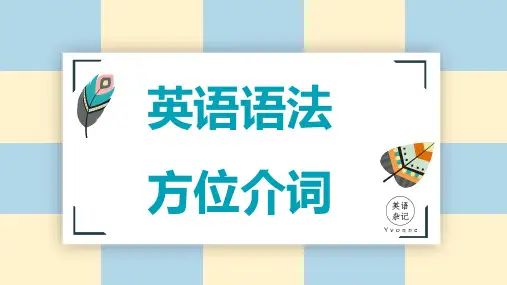
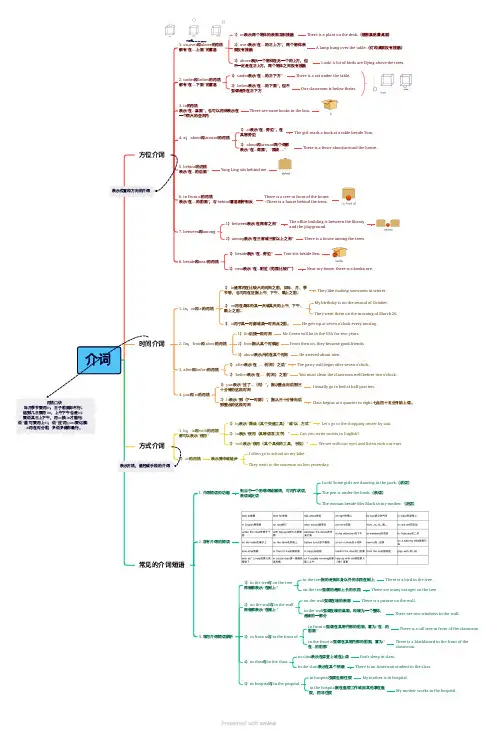
介词⽅位介词时间介词⽅式介词常⻅的介词短语 1. on,over 和above 的⽤法都有“在....上⾯”的意思1)on 表示两个物体的表⾯互相接触 2)over 表示“在....的正上⽅”,两个物体表⾯没有接触 3)above 表示⼀个物体在另⼀个的上⽅,但不⼀定是在正上⽅,两个物体之间没有接触 2. under 和below 的⽤法都有“在....下⾯”的意思1)under 表示“在....的正下⽅” 2)below 表示“在....的下⾯”,但不强调是否在正下⽅3. in 的⽤法表示“在...⾥⾯”,也可以⽤来表示在⼀个很⼤的空间内T here are some books in the box.4. at ,about 和around 的⽤法1)at 表示“在...旁边”,在某物旁边 2)about 和around 两个词都表示“在...周围”,“围绕....” 5. behind 的⽤法表示“在...的后⾯”Y ang Ling sits behind me.7. between 和among1)between 表示“在两者之间”2)among 表示“在三者或三者以上之间”8. beside 和near 的⽤法1)beside 表示“在...旁边” 2)near 表示“在...附近(范围⽐较⼴”) 6. in front of 的⽤法表示“在....的前⾯”,与behind 意思刚好相反 There is a tree in front of the house.=There is a house behind the tress.1. in ,on 和at 的⽤法 1)in 通常⽤在⽐较⼤的时间之前,如年、⽉、季节等,也可⽤在泛指上午、下午、晚上之前;T hey like making snowmen in winter. 2)on ⽤在具体的某⼀天或某天的上午、下午、晚上之前;M y birthday is on the second of October.T hey went there on the morning of March 26.3)at ⽤于某⼀时刻或某⼀时间点之前。
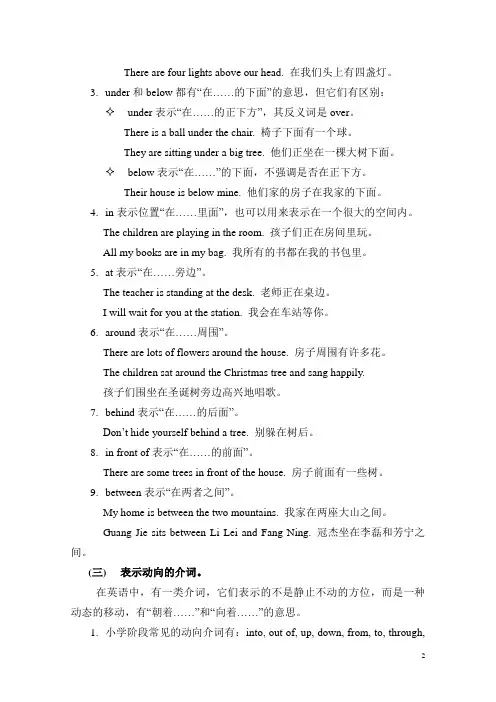
常见介词及用法(一)表示时间的介词1.英语里最常见的时间介词有:at, in, on, before, after和from。
2.at , in和on这三个词都表示时间。
✧at主要指具体的钟点:at half past eight 在八点半✧in一般指某一段时间:in January 在一月份✧on指具体在某一天:on Monday 在星期一3.before和after表示时间的先后顺序。
✧before表示“在……之前”。
You should wash your hands before eating. 吃饭前你应该洗手。
✧after表示“在……之后”。
They often play basketball after dinner. 他们放学后经常打篮球。
4.from作时间介词含有“从……开始”的意思,常和to连用,组成“from…to…”的结构,表示“从……到……”的意思。
We go to school from Monday to Friday. 我们从周一到周五上学。
(二)表示方位的介词,也就是表示位置和地点的介词。
1.小学阶段常见的方位介词有:on, in, at, under, over, above, below, about,around, between等。
2.on, over和above这三个词都有“在……上面”的意思,但它们所表示的方位还是有些不同。
✧on表示两个物体的表面相互接触。
如:There is a book on the desk. 桌上有一本书。
The boy is sleeping on the desk. 那个孩子睡在地上。
✧over表示“在……的正上方”,两个物体表面没有接触。
如:There is a light bulb over my head. 在我头顶上有一个灯泡。
✧above表示两个物体中一个在另一个的上方,如:The plane is flying above the clouds. 飞机上云层上飞行。
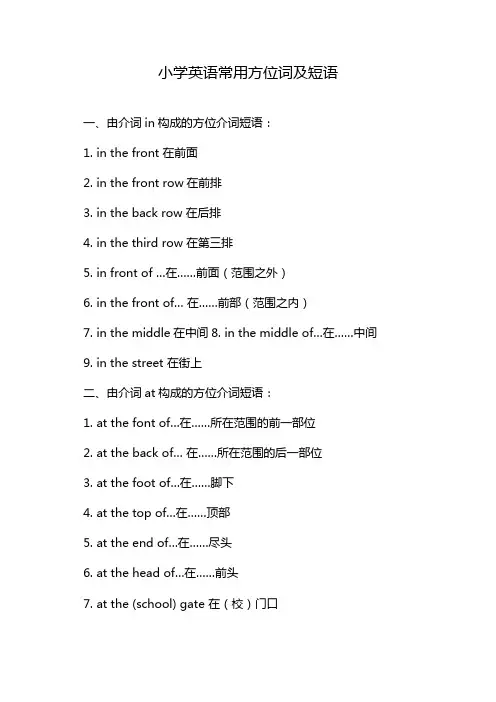
小学英语常用方位词及短语一、由介词in构成的方位介词短语:1. in the front 在前面2. in the front row在前排3. in the back row 在后排4. in the third row 在第三排5. in front of …在……前面(范围之外)6. in the front of…在……前部(范围之内)7. in the middle在中间8. in the middle of…在……中间9. in the street 在街上二、由介词at构成的方位介词短语:1. at the font of…在……所在范围的前一部位2. at the back of…在……所在范围的后一部位3. at the foot of…在……脚下4. at the top of…在……顶部5. at the end of…在……尽头6. at the head of…在……前头7. at the (school) gate 在(校)门口8. at the station 在车站9. at No. 2 Changan Road 在长安路2号10. at my uncle’s在我叔叔家11. at home 在家12. at the doctor’s在医务室/在诊所三、由介词on构成的方位介词短语:1. on the right / left 在右(左)边2. on one’s right / left 在某人的右(左)边3. on the desk / table 在课桌/桌上4. on the right–hand / left–hand side 在右/左手边5. on the blackboard 在黑板上6. on / in the wall 在墙上/里7. on the paper 在纸上四、由其它介词构成的方位介词短语:1. next to 靠近/贴近2. beside the desk 在课桌旁3. behind the door 在门后4. under the bed 在床下5. near the window 靠近窗户6. outside the gate 在门外7. between A and B 在A和B之间8. among the hills 在山中。
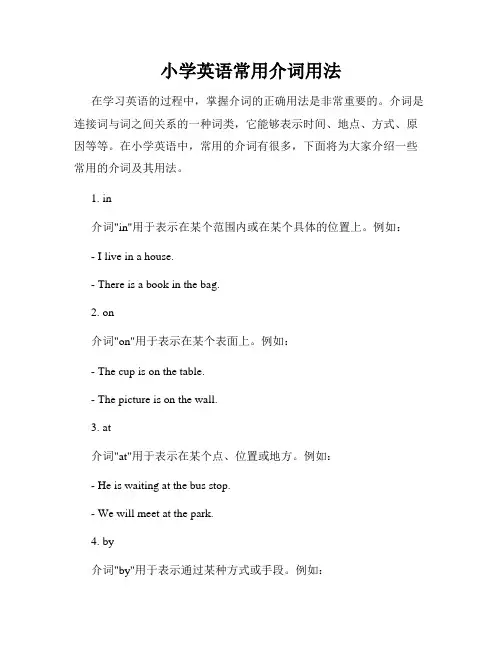
小学英语常用介词用法在学习英语的过程中,掌握介词的正确用法是非常重要的。
介词是连接词与词之间关系的一种词类,它能够表示时间、地点、方式、原因等等。
在小学英语中,常用的介词有很多,下面将为大家介绍一些常用的介词及其用法。
1. in介词"in"用于表示在某个范围内或在某个具体的位置上。
例如:- I live in a house.- There is a book in the bag.2. on介词"on"用于表示在某个表面上。
例如:- The cup is on the table.- The picture is on the wall.3. at介词"at"用于表示在某个点、位置或地方。
例如:- He is waiting at the bus stop.- We will meet at the park.4. by介词"by"用于表示通过某种方式或手段。
例如:- I go to school by bus.- They communicate by email.5. for介词"for"用于表示目的、原因或表示给予的对象。
例如:- This gift is for you.- I study hard for good grades.6. with介词"with"用于表示陪伴或伴随的状态。
例如:- She went to the park with her friends.- He plays basketball with his brother.7. to介词"to"用于表示目的、方向、接触等。
例如:- I go to school every day.- She gives a present to her teacher.8. from介词"from"用于表示出发地、来源或起点。
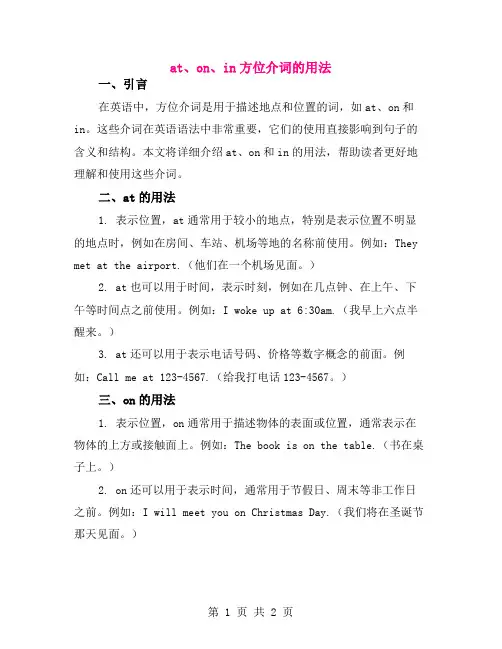
at、on、in方位介词的用法一、引言在英语中,方位介词是用于描述地点和位置的词,如at、on和in。
这些介词在英语语法中非常重要,它们的使用直接影响到句子的含义和结构。
本文将详细介绍at、on和in的用法,帮助读者更好地理解和使用这些介词。
二、at的用法1. 表示位置,at通常用于较小的地点,特别是表示位置不明显的地点时,例如在房间、车站、机场等地的名称前使用。
例如:They met at the airport.(他们在一个机场见面。
)2. at也可以用于时间,表示时刻,例如在几点钟、在上午、下午等时间点之前使用。
例如:I woke up at 6:30am.(我早上六点半醒来。
)3. at还可以用于表示电话号码、价格等数字概念的前面。
例如:Call me at 123-4567.(给我打电话123-4567。
)三、on的用法1. 表示位置,on通常用于描述物体的表面或位置,通常表示在物体的上方或接触面上。
例如:The book is on the table.(书在桌子上。
)2. on还可以用于表示时间,通常用于节假日、周末等非工作日之前。
例如:I will meet you on Christmas Day.(我们将在圣诞节那天见面。
)3. on还可以用于表示电视节目、广播节目等的播放时间。
例如:Please turn on the TV and watch the news at 7pm.(请打开电视在晚上七点观看新闻。
)四、in的用法1. 表示位置,in通常用于描述较大的地方或物体内部,例如房间、教室、学校、建筑物等场所的前面或里面。
例如:We meet in the classroom every day.(我们每天在教室见面。
)2. in还可以用于表示衣服或物体的尺寸或大小。
例如:She wears a dress in size 8.(她穿着8号的连衣裙。
)3. in也可以用于时间和年代的表述中,通常用于具体的日期或年份之前。
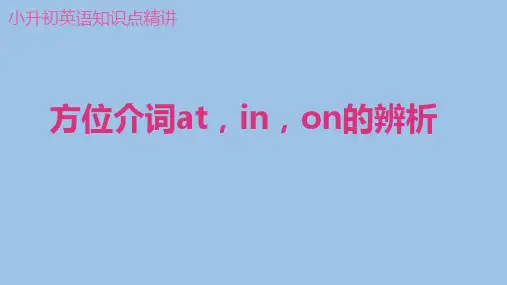
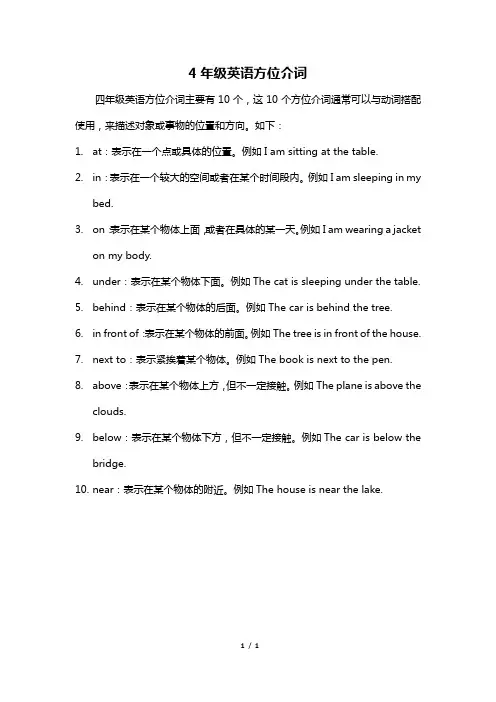
4年级英语方位介词
四年级英语方位介词主要有10个,这10个方位介词通常可以与动词搭配使用,来描述对象或事物的位置和方向。
如下:
1.at:表示在一个点或具体的位置。
例如I am sitting at the table.
2.in:表示在一个较大的空间或者在某个时间段内。
例如I am sleeping in my
bed.
3.on:表示在某个物体上面,或者在具体的某一天。
例如I am wearing a jacket
on my body.
4.under:表示在某个物体下面。
例如The cat is sleeping under the table.
5.behind:表示在某个物体的后面。
例如The car is behind the tree.
6.in front of:表示在某个物体的前面。
例如The tree is in front of the house.
7.next to:表示紧挨着某个物体。
例如The book is next to the pen.
8.above:表示在某个物体上方,但不一定接触。
例如The plane is above the
clouds.
9.below:表示在某个物体下方,但不一定接触。
例如The car is below the
bridge.
10.near:表示在某个物体的附近。
例如The house is near the lake.
1/ 1。
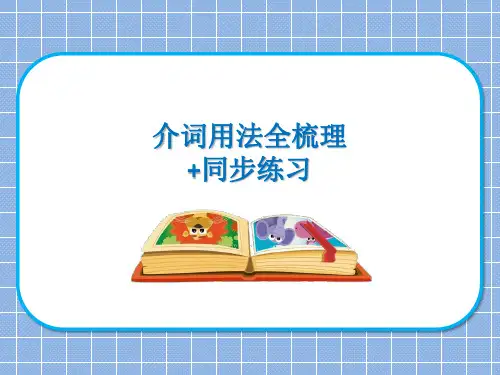
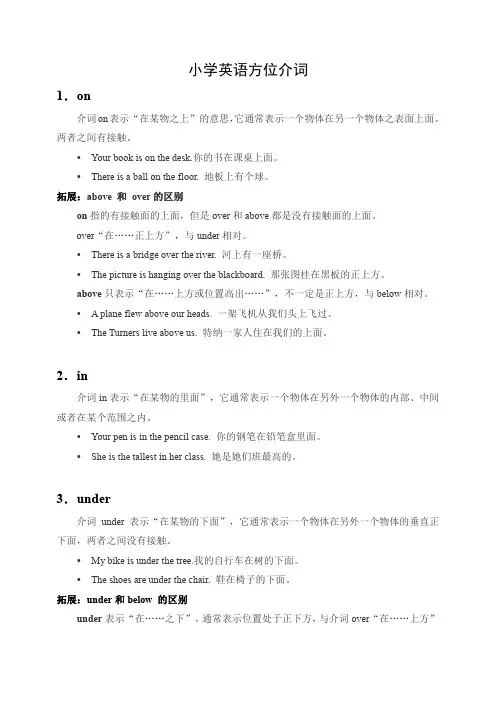
小学英语方位介词1.on介词on表示“在某物之上”的意思,它通常表示一个物体在另一个物体之表面上面。
两者之间有接触。
•Your book is on the desk.你的书在课桌上面。
•There is a ball on the floor. 地板上有个球。
拓展:above 和over的区别on指的有接触面的上面,但是over和above都是没有接触面的上面。
over“在……正上方”,与under相对。
•There is a bridge over the river. 河上有一座桥。
•The picture is hanging over the blackboard. 那张图挂在黑板的正上方。
above只表示“在……上方或位置高出……”,不一定是正上方,与below相对。
• A plane flew above our heads. 一架飞机从我们头上飞过。
•The Turners live above us. 特纳一家人住在我们的上面。
2.in介词in表示“在某物的里面”,它通常表示一个物体在另外一个物体的内部、中间或者在某个范围之内。
•Your pen is in the pencil case. 你的钢笔在铅笔盒里面。
•She is the tallest in her class. 她是她们班最高的。
3.under介词under表示“在某物的下面”,它通常表示一个物体在另外一个物体的垂直正下面,两者之间没有接触。
•My bike is under the tree.我的自行车在树的下面。
•The shoes are under the chair. 鞋在椅子的下面。
拓展:under和below 的区别under表示“在……之下”,通常表示位置处于正下方,与介词over“在……上方”相对应。
•There is a book under the table.桌子下面有一本书。
• A cat is sitting under the table.一只猫在桌子下面。
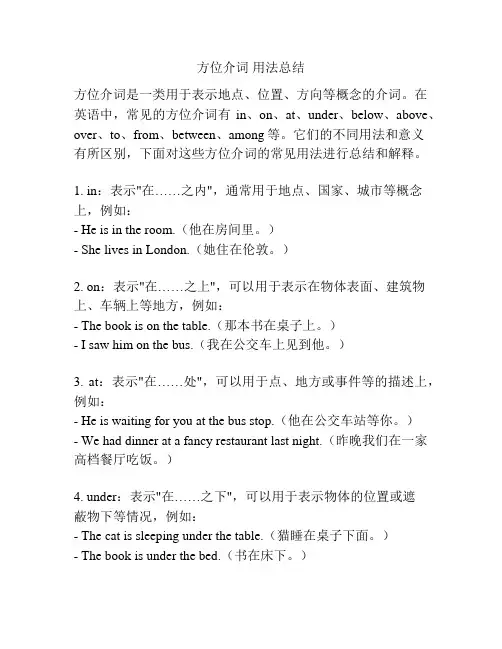
方位介词用法总结方位介词是一类用于表示地点、位置、方向等概念的介词。
在英语中,常见的方位介词有in、on、at、under、below、above、over、to、from、between、among等。
它们的不同用法和意义有所区别,下面对这些方位介词的常见用法进行总结和解释。
1. in:表示"在……之内",通常用于地点、国家、城市等概念上,例如:- He is in the room.(他在房间里。
)- She lives in London.(她住在伦敦。
)2. on:表示"在……之上",可以用于表示在物体表面、建筑物上、车辆上等地方,例如:- The book is on the table.(那本书在桌子上。
)- I saw him on the bus.(我在公交车上见到他。
)3. at:表示"在……处",可以用于点、地方或事件等的描述上,例如:- He is waiting for you at the bus stop.(他在公交车站等你。
)- We had dinner at a fancy restaurant last night.(昨晚我们在一家高档餐厅吃饭。
)4. under:表示"在……之下",可以用于表示物体的位置或遮蔽物下等情况,例如:- The cat is sleeping under the table.(猫睡在桌子下面。
)- The book is under the bed.(书在床下。
)5. below:表示"在……以下",可以用于比较高度、水平或等级等的描述上,例如:- The temperature dropped below freezing last night.(昨晚气温降到了冰点以下。
)- He ranks below his brother in the class.(他在班里的排名在他弟弟之下。
以下是常见的英语方位介词的列表:
1.Above - 在...之上
2.Across - 穿过,横过
3.After - 在...后面
4.Against - 靠着,依靠
5.Along - 沿着
6.Among - 在...之中
7.Around - 在周围
8.At - 在...处
9.Behind - 在...后面
10.Below - 在...之下
11.Beside - 在...旁边
12.Between - 在...之间
13.Beyond - 在...之外
14.By - 在...旁边,靠近
15.Down - 沿着,向下
16.From - 从...出发
17.In - 在...里面
18.Inside - 在...内部
19.Into - 进入
20.Near - 在...附近
21.Off - 离开
22.On - 在...上面
23.Onto - 到...上面
24.Out - 出去
25.Outside - 在...外部
26.Over - 在...上方
27.Past - 经过
28.Round - 绕过
29.Through - 穿过
30.To - 到...处
31.Toward(s) - 朝向
32.Under - 在...下面
33.Up - 向上
34.With - 带着
这些方位介词可以用来描述位置、方向和关系,帮助我们准确地表达位置和运动。
请注意,一些介词可能有多种用法和意义,具体用法会根据上下文而有所变化。
三一文库()/小学一年级〔小学英语语法方位介词辨析[1]〕1. at, in, onat 一般指小地方;in 一般指大地方或某个范围之内;on 往往表示“在某个物体的表面”。
例如:He arrived in Shanghai yesterday. 他昨天到上海。
They arrived at a small village before dark. 他们在天黑前到达一个小村庄。
There is a big hole in the wall. 墙上有个大洞。
The teacher hung a picture on the wall. 老师把一幅画挂在墙上。
2. over, above, onover, on 和 above 都可表示“在……上面”,但具体含义不同。
Over 表示位置高于某物,在某物的正上方,其反义词是under。
above 也表示位置高于某物,但不一定在正上方,其反义词是below。
On 指两个物体表面接触,一个在另一的上面。
例如:There is a bridge over the river. 河上有一座桥。
We flew above the clouds. 我们飞越云层。
They put some flowers on the teacher's desk. 他们把一些花放在讲桌上。
3. across, throughacross 和 through 均可表示“从这一边到另一边”,但用法不同。
Across 的含义与 on 有关,表示动作在某一物体的表面进行。
Through 的含义与 in 有关,表示动作是在三维空间进行。
例如:The dog ran across the grass. 狗跑过草地。
The boy swam across the river. 那男孩游过河。
They walked through the forest. 他们穿过森林。
I pushed through the crowds. 我挤过人群。
英语方位介词1. along:沿着…,顺着…I'm walking along the river.我正沿河而行。
2. across:从一边到另一边,在…那边There are many trees across the river. 河对岸有很多树。
3. towards:向…,朝…I'm walking towards the house.我正朝房子走去。
4. in front of:在…的前面There is a fruit tree in front of the house.房子前面有一棵果树。
5. behind:在…之后There is another fruit tree behind the house.房后还有一棵果树。
6. into:到…里,进入内部I want to go into the house.我想走进房子。
7. inside:在…的里面,在…内部I am inside the house now.我正在房子里。
8. outside:在…外面Now I am outside the house.我现在来到房外。
9. in:在…里,表示在含有空间感的范围或物体之中There is nobody in the house.房子里面没有人。
10. above:在…之上,表示高于,不是垂直的There are lots of apples above my head.我的头顶上有很多苹果。
11. under:在…正下方,强调垂直在…之下I want to have a rest under the tree. 我想在树下休息一会儿。
12. off:从…脱落,从…掉下13.on:在…之上,与…表面相接触An apple falls off the tree and hits me on the head.一只苹果从树上掉下砸在我的头上。
小学英语趣说图解方位介词方位介词是介词比较重要的一个分类。
利用图片记忆方位介词,能帮助学生加深印象,考试时更容易唤醒大脑的深层记忆。
现在就开始记忆吧!1. inin 表示小范围在一个大范围的里面,表示“在某范围之内”,强调两者的包含关系。
如:Beijing is in the north of China.北京在中国的北部。
2. onon 表示一个范围紧挨着另一个范围,表示“两地接壤”,强调两者为相邻关系;还表示“在……上”,并与之相接触。
如:Korea is on the northeast of China.朝鲜在中国的东北面。
He put the computer on the desk.他把电脑放在桌子上。
3. toto 表示一个范围和另一个范围之间隔段距离,表示“在某范围之外”,强调两者是远离关系。
如:Japan is to the east of China.日本位于中国的东边。
4. atat 表示在某地点,强调在某个位置点。
如:I met Mary at the school gate this morning.我今天早上在校门口遇见了玛丽。
5. under 和 belowunder表示“在……的正下方”,指垂直上下。
below表示“在……的下方”,只表示位置低于,但不是在正下方。
如:There is a cat under the table.桌子下面有一只猫。
He saw many hills and rivers below the plane.他看见飞机的下方有许多小山和河流。
6. over 和 aboveover表示“在……垂直的上方”,与under相对;above表示“在……的上方”,指高于某物,但不是正上方,与below相对。
如:She is holding an umbrella over her head. 她撑着一把伞遮头。
An airplane flew above the clouds.一架飞机在云端上面飞行。
一. 平面方位1.1“前”&“后”in front of “在…前面”(在物体外的前面)in the front of “在…前部”(在物体内部的前面)behind “在…后面”(在物体外的后面)at the back of “在…后部”(在物体内部的后面)1.2 “在左边”on the left (of)“在右边”on the right (of)“在…中间”in the middle (of)1.3 在两者之间between在三者或者以上之间among如右图所示:The teacher is sitting between the twins.Lucy is dancing among her classmates.1.4“对面”opposite二、表示地点的介词in、on、behind、next to、near、over、under(1). in在……里面:The pencil is in the desk. 铅笔在课桌里。
(2). on在……上面:There are some apple on the tree. 树上有些苹果。
(3). under在……下面/正下方:What's under your desk? 你书桌底下是什么?(4). over在……正上方:There is a shelf over the table. 桌子上方有一个书架。
(5). above 在……斜上方:Raise your arms above your head.(6). below 在……斜下方:Her skirt came below her knees.(7).behind在……之后:There is a bike behind the tree. 树后有一辆自行车。
(8).next to在……旁边:There is a café next to the barber's. 理发店隔壁是一家咖啡馆。